display Alfa Romeo 147 2006 Owner handbook (in English)
[x] Cancel search | Manufacturer: ALFA ROMEO, Model Year: 2006, Model line: 147, Model: Alfa Romeo 147 2006Pages: 291, PDF Size: 5.52 MB
Page 130 of 291
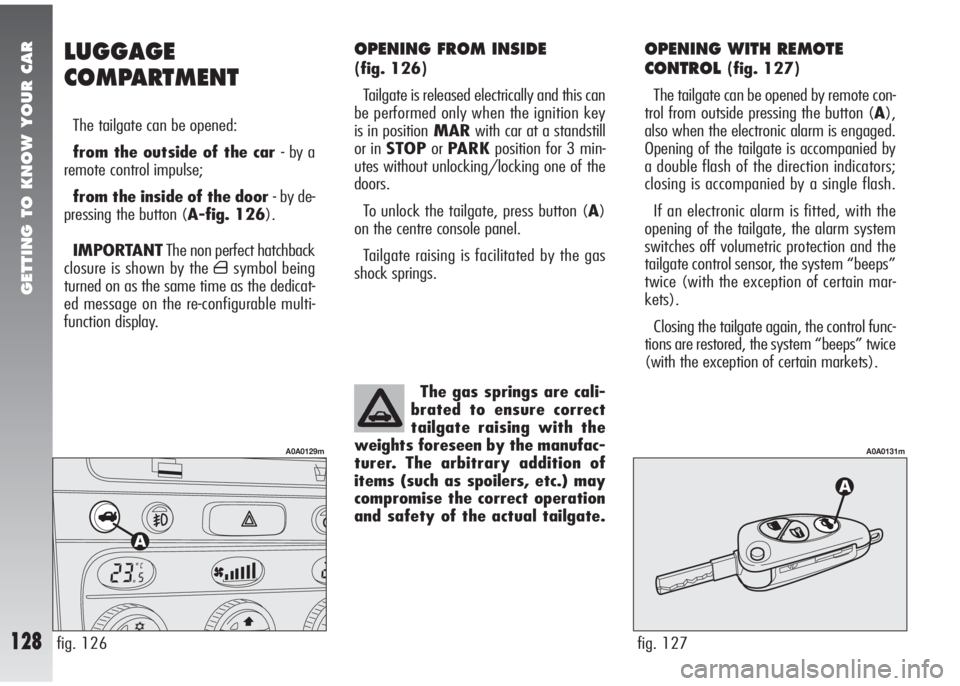
GETTING TO KNOW YOUR CAR
128
OPENING FROM INSIDE
(fig. 126)
Tailgate is released electrically and this can
be performed only when the ignition key
is in positionMARwith car at a standstill
or in STOPorPARKposition for 3 min-
utes without unlocking/locking one of the
doors.
To unlock the tailgate, press button (A)
on the centre console panel.
Tailgate raising is facilitated by the gas
shock springs.
OPENING WITH REMOTE
CONTROL
(fig. 127)
The tailgate can be opened by remote con-
trol from outside pressing the button (A),
also when the electronic alarm is engaged.
Opening of the tailgate is accompanied by
a double flash of the direction indicators;
closing is accompanied by a single flash.
If an electronic alarm is fitted, with the
opening of the tailgate, the alarm system
switches off volumetric protection and the
tailgate control sensor, the system “beeps”
twice (with the exception of certain mar-
kets).
Closing the tailgate again, the control func-
tions are restored, the system “beeps” twice
(with the exception of certain markets).
The gas springs are cali-
brated to ensure correct
tailgate raising with the
weights foreseen by the manufac-
turer. The arbitrary addition of
items (such as spoilers, etc.) may
compromise the correct operation
and safety of the actual tailgate.
fig. 127
A0A0131m
LUGGAGE
COMPARTMENT
The tailgate can be opened:
from the outside of the car - by a
remote control impulse;
from the inside of the door - by de-
pressing the button (A-fig. 126).
IMPORTANTThe non perfect hatchback
closure is shown by the
´symbol being
turned on as the same time as the dedicat-
ed message on the re-configurable multi-
function display.
fig. 126
A0A0129m
Page 134 of 291

GETTING TO KNOW YOUR CAR
132fig. 135
A0A0199m
For correct adjustment, bear in mind the
following conditions:
– position 0: one or two people occupy-
ing the front seats
– position 1: five people;
– position 2: five people + load in the
boot;
– position 3: driver + maximum permis-
sible load all stowed in lug-
gage compartmentCOMPENSATION FOR TILT
(fig. 134)(excluding versions
with Xenon headlights)
When the vehicle is loaded, the beam from
the headlights is raised due to the back-
wards tilt of the vehicle.
In this case the headlights must be ad-
justed correctly.
To do this, use the rocker button (A), on
the plate at the side of the steering column:
– press the arrow on the button (
A), this
will increase by one position (eg.: 0
➟1
➟ 2➟3);
– press the arrow on the button (
S), this
will lower by one position (eg.: 3
➟2➟
1➟0);
The display (B), in the tachometer shows
the positions while adjustment is being
made.
fig. 134
A0A0467m
HEADLIGHTS
The adjustment of the headlights is vital to
your safety and comfort and to that of oth-
er road users.
The adjustment of the headlights is also
governed by precise regulations.
Contact Alfa Romeo Authorised Services to
have the headlights correctly adjusted.
IMPORTANTOn the inside surface of
the headlight there could appear a slight
coat of fogging; this does not show a defect,
since it is a natural occurrence due to low
temperature and to the degree of humidity
in the air; it will soon disappear as soon as
the lights are turned on. The presence of
drops inside the headlight shows water seep-
age, refer to the Alfa Romeo Dealership.
Check beam aiming every
time the load carried
changes.
WARNING
Page 135 of 291
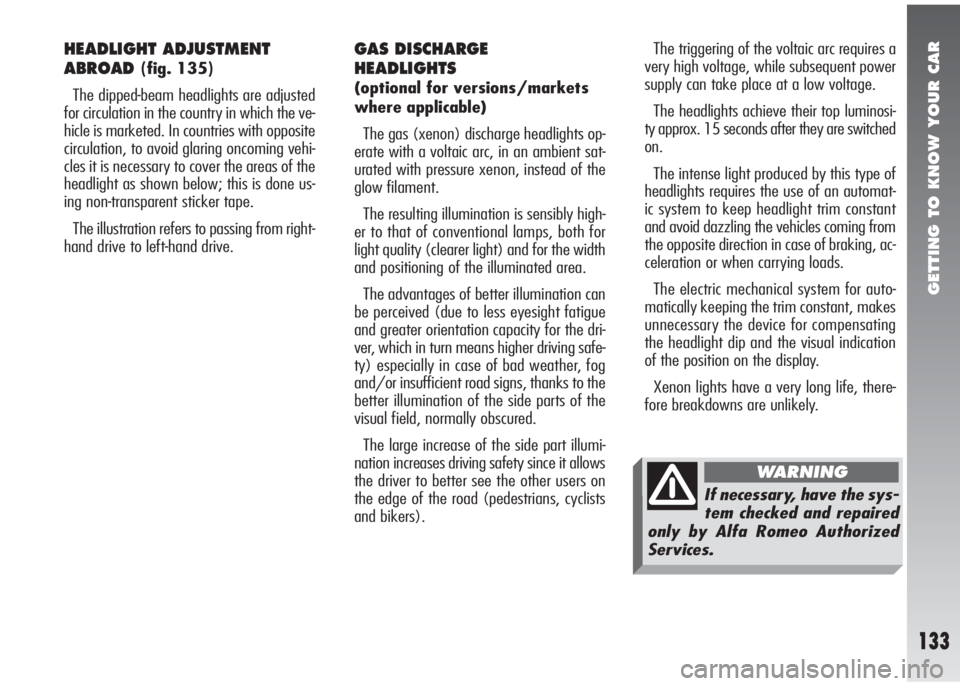
GETTING TO KNOW YOUR CAR
133
HEADLIGHT ADJUSTMENT
ABROAD
(fig. 135)
The dipped-beam headlights are adjusted
for circulation in the country in which the ve-
hicle is marketed. In countries with opposite
circulation, to avoid glaring oncoming vehi-
cles it is necessary to cover the areas of the
headlight as shown below; this is done us-
ing non-transparent sticker tape.
The illustration refers to passing from right-
hand drive to left-hand drive.
GAS DISCHARGE
HEADLIGHTS
(optional for versions/markets
where applicable)
The gas (xenon) discharge headlights op-
erate with a voltaic arc, in an ambient sat-
urated with pressure xenon, instead of the
glow filament.
The resulting illumination is sensibly high-
er to that of conventional lamps, both for
light quality (clearer light) and for the width
and positioning of the illuminated area.
The advantages of better illumination can
be perceived (due to less eyesight fatigue
and greater orientation capacity for the dri-
ver, which in turn means higher driving safe-
ty) especially in case of bad weather, fog
and/or insufficient road signs, thanks to the
better illumination of the side parts of the
visual field, normally obscured.
The large increase of the side part illumi-
nation increases driving safety since it allows
the driver to better see the other users on
the edge of the road (pedestrians, cyclists
and bikers).The triggering of the voltaic arc requires a
very high voltage, while subsequent power
supply can take place at a low voltage.
The headlights achieve their top luminosi-
ty approx. 15 seconds after they are switched
on.
The intense light produced by this type of
headlights requires the use of an automat-
ic system to keep headlight trim constant
and avoid dazzling the vehicles coming from
the opposite direction in case of braking, ac-
celeration or when carrying loads.
The electric mechanical system for auto-
matically keeping the trim constant, makes
unnecessary the device for compensating
the headlight dip and the visual indication
of the position on the display.
Xenon lights have a very long life, there-
fore breakdowns are unlikely.
If necessary, have the sys-
tem checked and repaired
only by Alfa Romeo Authorized
Services.
WARNING
Page 139 of 291
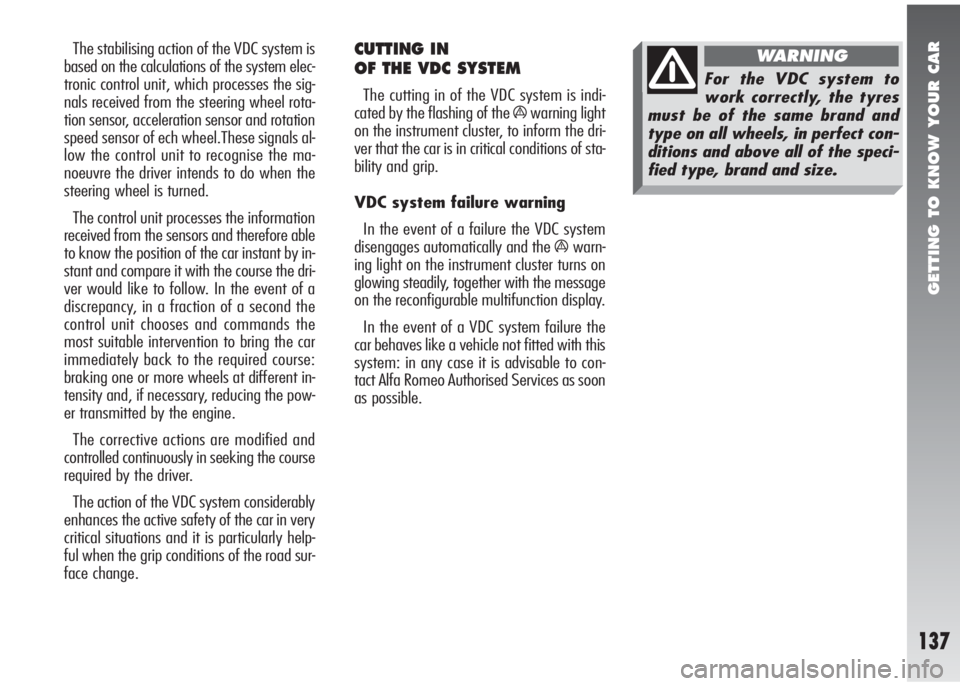
GETTING TO KNOW YOUR CAR
137
The stabilising action of the VDC system is
based on the calculations of the system elec-
tronic control unit, which processes the sig-
nals received from the steering wheel rota-
tion sensor, acceleration sensor and rotation
speed sensor of ech wheel.These signals al-
low the control unit to recognise the ma-
noeuvre the driver intends to do when the
steering wheel is turned.
The control unit processes the information
received from the sensors and therefore able
to know the position of the car instant by in-
stant and compare it with the course the dri-
ver would like to follow. In the event of a
discrepancy, in a fraction of a second the
control unit chooses and commands the
most suitable intervention to bring the car
immediately back to the required course:
braking one or more wheels at different in-
tensity and, if necessary, reducing the pow-
er transmitted by the engine.
The corrective actions are modified and
controlled continuously in seeking the course
required by the driver.
The action of the VDC system considerably
enhances the active safety of the car in very
critical situations and it is particularly help-
ful when the grip conditions of the road sur-
face change.CUTTING IN
OF THE VDC SYSTEM
The cutting in of the VDC system is indi-
cated by the flashing of the
áwarning light
on the instrument cluster, to inform the dri-
ver that the car is in critical conditions of sta-
bility and grip.
VDC system failure warning
In the event of a failure the VDC system
disengages automatically and the
áwarn-
ing light on the instrument cluster turns on
glowing steadily, together with the message
on the reconfigurable multifunction display.
In the event of a VDC system failure the
car behaves like a vehicle not fitted with this
system: in any case it is advisable to con-
tact Alfa Romeo Authorised Services as soon
as possible.
For the VDC system to
work correctly, the tyres
must be of the same brand and
type on all wheels, in perfect con-
ditions and above all of the speci-
fied type, brand and size.
WARNING
Page 140 of 291

GETTING TO KNOW YOUR CAR
138
SWITCHING ON
THE ASR FUNCTION
The ASR function switches on automati-
cally each time the engine is started.
When travelling the device can be switched
off and on again pressing switch (A-
fig. 136) on the centre console.
Function disconnection is shown by the rel-
evant led on the switch itself being turned
on and by the dedicated message displayed
on the re-configurable multifunction display.
Should the function be disconnected when
running, it will automatically be activated
again at the next ignition and the re-con-
figurable multifunction display will inform
user about this condition by displaying a ded-
icated message.
fig. 136
A0A0140m
ASR SYSTEM
(Antislip Regulation)
The ASR function controls the vehicle dri-
ve and cuts in automatically every time one
or both driving wheels slip.
In slipping conditions, two different control
systems are activated:
1) if slipping involves both driving wheels,
being caused by excessive power transmit-
ted, the ASR device cuts in reducing the pow-
er transmitted by the engine.
2) if slipping involves only one driving
wheel, the ASR system cuts in automatical-
ly braking the wheel that is slipping, with
an effect similar to that of a self-locking dif-
ferential.
The action of the ASR is particularly help-
ful in the following circumstances:
– slipping of the inner wheel on a bend,
due to the effect of dynamic load changes
or excessive acceleration.
– too much power transmitted to the
wheels also in relation to the conditions of
the road surface.
– acceleration on slippery, snowy or frozen
surfaces.
– in the case of loss of grip on a wet sur-
face (aquaplaning).The performance of the
system in terms of active
safety should not induce the driver
to take pointless and unnecessary
risks. The style of driving must in
any case be adapted to the condi-
tions of the road surface, visibili-
ty and traffic. Road safety is al-
ways the driver’s responsibility.
WARNING
Page 141 of 291
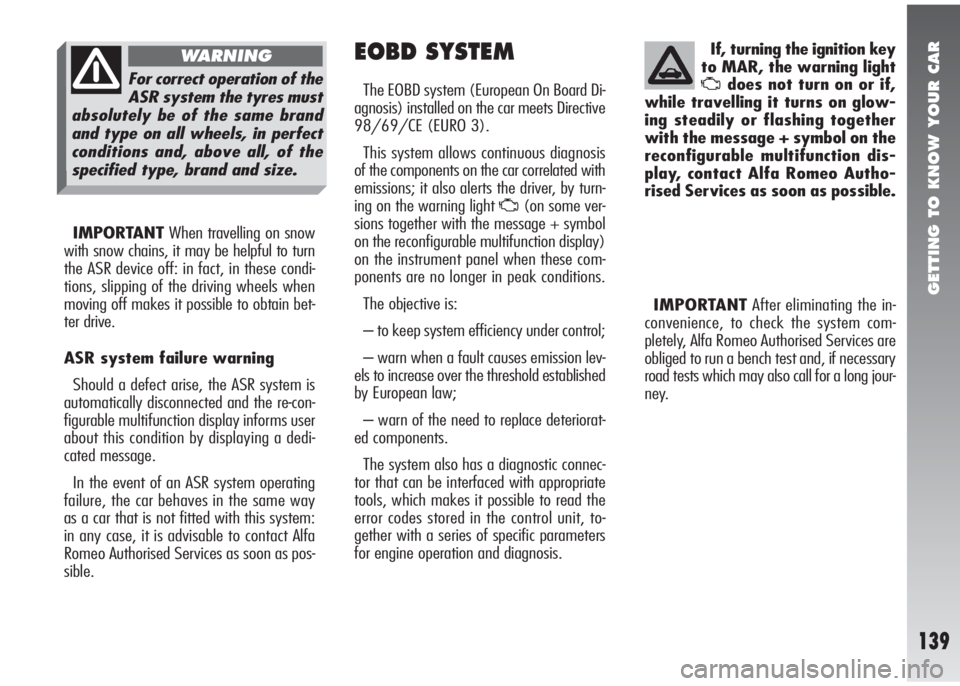
GETTING TO KNOW YOUR CAR
139
IMPORTANTWhen travelling on snow
with snow chains, it may be helpful to turn
the ASR device off: in fact, in these condi-
tions, slipping of the driving wheels when
moving off makes it possible to obtain bet-
ter drive.
ASR system failure warning
Should a defect arise, the ASR system is
automatically disconnected and the re-con-
figurable multifunction display informs user
about this condition by displaying a dedi-
cated message.
In the event of an ASR system operating
failure, the car behaves in the same way
as a car that is not fitted with this system:
in any case, it is advisable to contact Alfa
Romeo Authorised Services as soon as pos-
sible.
EOBD SYSTEM
The EOBD system (European On Board Di-
agnosis) installed on the car meets Directive
98/69/CE (EURO 3).
This system allows continuous diagnosis
of the components on the car correlated with
emissions; it also alerts the driver, by turn-
ing on the warning light
U(on some ver-
sions together with the message + symbol
on the reconfigurable multifunction display)
on the instrument panel when these com-
ponents are no longer in peak conditions.
The objective is:
– to keep system efficiency under control;
– warn when a fault causes emission lev-
els to increase over the threshold established
by European law;
– warn of the need to replace deteriorat-
ed components.
The system also has a diagnostic connec-
tor that can be interfaced with appropriate
tools, which makes it possible to read the
error codes stored in the control unit, to-
gether with a series of specific parameters
for engine operation and diagnosis.If, turning the ignition key
to MAR, the warning light
Udoes not turn on or if,
while travelling it turns on glow-
ing steadily or flashing together
with the message + symbol on the
reconfigurable multifunction dis-
play, contact Alfa Romeo Autho-
rised Services as soon as possible.
IMPORTANTAfter eliminating the in-
convenience, to check the system com-
pletely, Alfa Romeo Authorised Services are
obliged to run a bench test and, if necessary
road tests which may also call for a long jour-
ney.For correct operation of the
ASR system the tyres must
absolutely be of the same brand
and type on all wheels, in perfect
conditions and, above all, of the
specified type, brand and size.
WARNING
Page 146 of 291
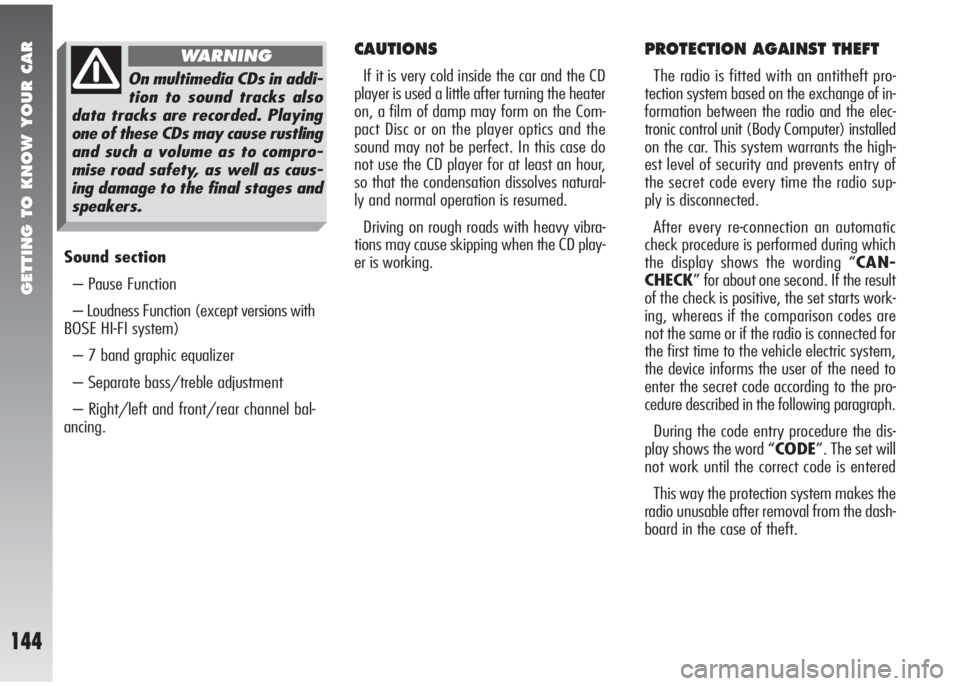
GETTING TO KNOW YOUR CAR
144
Sound section
– Pause Function
– Loudness Function (except versions with
BOSE HI-FI system)
– 7 band graphic equalizer
– Separate bass/treble adjustment
– Right/left and front/rear channel bal-
ancing.
CAUTIONS
If it is very cold inside the car and the CD
player is used a little after turning the heater
on, a film of damp may form on the Com-
pact Disc or on the player optics and the
sound may not be perfect. In this case do
not use the CD player for at least an hour,
so that the condensation dissolves natural-
ly and normal operation is resumed.
Driving on rough roads with heavy vibra-
tions may cause skipping when the CD play-
er is working.
PROTECTION AGAINST THEFT
The radio is fitted with an antitheft pro-
tection system based on the exchange of in-
formation between the radio and the elec-
tronic control unit (Body Computer) installed
on the car. This system warrants the high-
est level of security and prevents entry of
the secret code every time the radio sup-
ply is disconnected.
After every re-connection an automatic
check procedure is performed during which
the display shows the wording “CAN-
CHECK” for about one second. If the result
of the check is positive, the set starts work-
ing, whereas if the comparison codes are
not the same or if the radio is connected for
the first time to the vehicle electric system,
the device informs the user of the need to
enter the secret code according to the pro-
cedure described in the following paragraph.
During the code entry procedure the dis-
play shows the word “CODE”. The set will
not work until the correct code is entered
This way the protection system makes the
radio unusable after removal from the dash-
board in the case of theft.On multimedia CDs in addi-
tion to sound tracks also
data tracks are recorded. Playing
one of these CDs may cause rustling
and such a volume as to compro-
mise road safety, as well as caus-
ing damage to the final stages and
speakers.
WARNING
Page 147 of 291
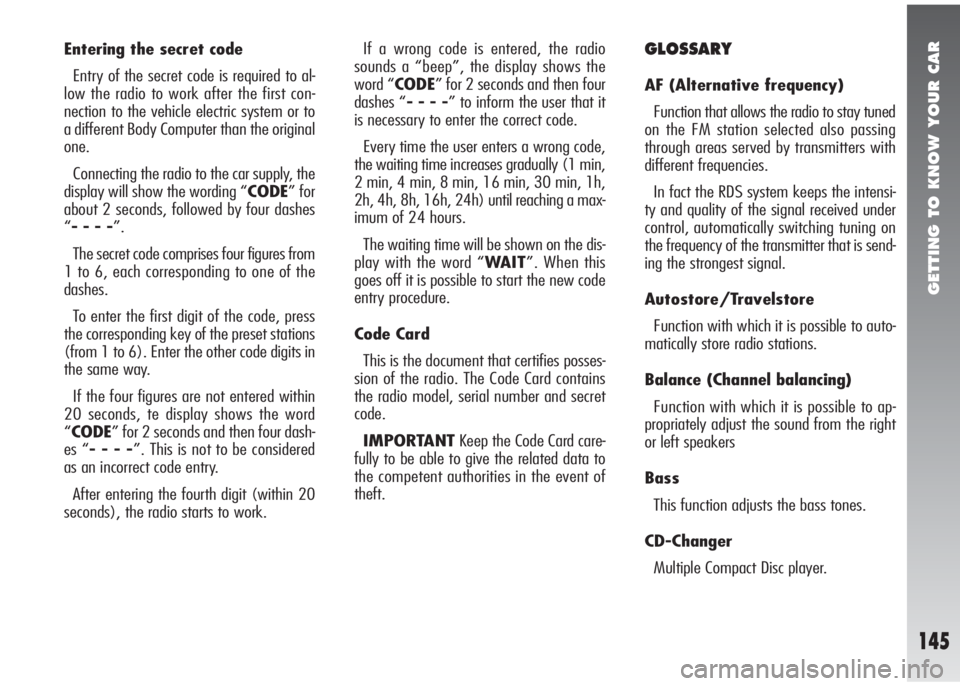
GETTING TO KNOW YOUR CAR
145
Entering the secret code
Entry of the secret code is required to al-
low the radio to work after the first con-
nection to the vehicle electric system or to
a different Body Computer than the original
one.
Connecting the radio to the car supply, the
display will show the wording “CODE” for
about 2 seconds, followed by four dashes
“- - - -”.
The secret code comprises four figures from
1 to 6, each corresponding to one of the
dashes.
To enter the first digit of the code, press
the corresponding key of the preset stations
(from 1 to 6). Enter the other code digits in
the same way.
If the four figures are not entered within
20 seconds, te display shows the word
“CODE” for 2 seconds and then four dash-
es “- - - -”. This is not to be considered
as an incorrect code entry.
After entering the fourth digit (within 20
seconds), the radio starts to work.If a wrong code is entered, the radio
sounds a “beep”, the display shows the
word “CODE” for 2 seconds and then four
dashes “- - - -” to inform the user that it
is necessary to enter the correct code.
Every time the user enters a wrong code,
the waiting time increases gradually (1 min,
2 min, 4 min, 8 min, 16 min, 30 min, 1h,
2h, 4h, 8h, 16h, 24h) until reaching a max-
imum of 24 hours.
The waiting time will be shown on the dis-
play with the word “WAIT”. When this
goes off it is possible to start the new code
entry procedure.
Code Card
This is the document that certifies posses-
sion of the radio. The Code Card contains
the radio model, serial number and secret
code.
IMPORTANTKeep the Code Card care-
fully to be able to give the related data to
the competent authorities in the event of
theft.GLOSSARY
AF (Alternative frequency)
Function that allows the radio to stay tuned
on the FM station selected also passing
through areas served by transmitters with
different frequencies.
In fact the RDS system keeps the intensi-
ty and quality of the signal received under
control, automatically switching tuning on
the frequency of the transmitter that is send-
ing the strongest signal.
Autostore/Travelstore
Function with which it is possible to auto-
matically store radio stations.
Balance (Channel balancing)
Function with which it is possible to ap-
propriately adjust the sound from the right
or left speakers
Bass
This function adjusts the bass tones.
CD-Changer
Multiple Compact Disc player.
Page 152 of 291
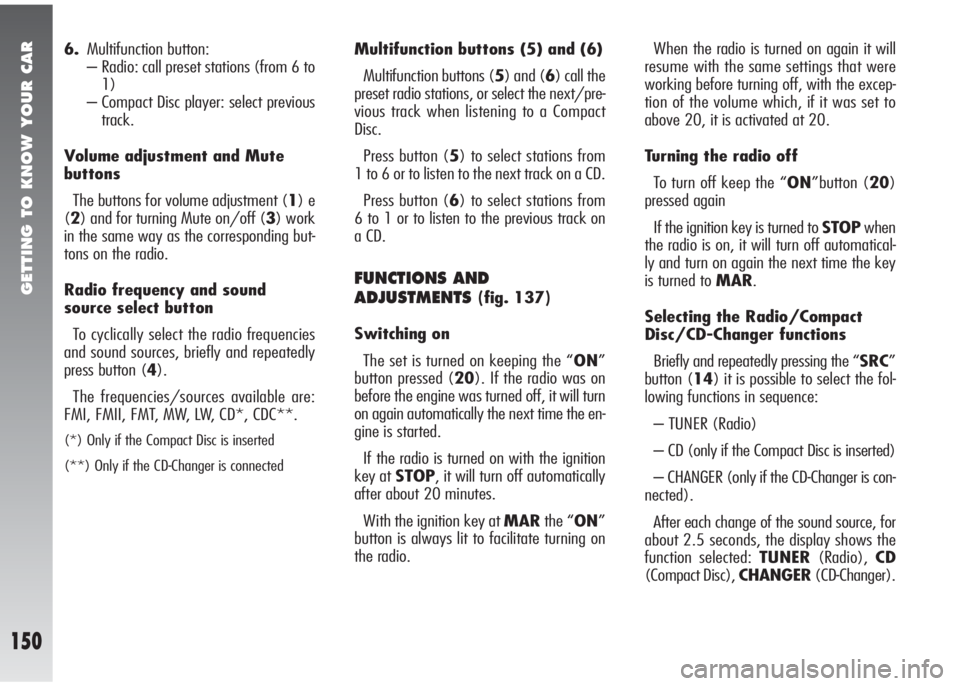
GETTING TO KNOW YOUR CAR
150
6.Multifunction button:
– Radio: call preset stations (from 6 to
1)
– Compact Disc player: select previous
track.
Volume adjustment and Mute
buttons
The buttons for volume adjustment (1) e
(2) and for turning Mute on/off (3) work
in the same way as the corresponding but-
tons on the radio.
Radio frequency and sound
source select button
To cyclically select the radio frequencies
and sound sources, briefly and repeatedly
press button (4).
The frequencies/sources available are:
FMI, FMII, FMT, MW, LW, CD*, CDC**.
(*) Only if the Compact Disc is inserted
(**) Only if the CD-Changer is connected
Multifunction buttons (5) and (6)
Multifunction buttons (5) and (6) call the
preset radio stations, or select the next/pre-
vious track when listening to a Compact
Disc.
Press button (5) to select stations from
1 to 6 or to listen to the next track on a CD.
Press button (6) to select stations from
6 to 1 or to listen to the previous track on
a CD.
FUNCTIONS AND
ADJUSTMENTS
(fig. 137)
Switching on
The set is turned on keeping the “ON”
button pressed (20). If the radio was on
before the engine was turned off, it will turn
on again automatically the next time the en-
gine is started.
If the radio is turned on with the ignition
key at STOP, it will turn off automatically
after about 20 minutes.
With the ignition key at MARthe “ON”
button is always lit to facilitate turning on
the radio.When the radio is turned on again it will
resume with the same settings that were
working before turning off, with the excep-
tion of the volume which, if it was set to
above 20, it is activated at 20.
Turning the radio off
To turn off keep the “ON”button (20)
pressed again
If the ignition key is turned to STOPwhen
the radio is on, it will turn off automatical-
ly and turn on again the next time the key
is turned to MAR.
Selecting the Radio/Compact
Disc/CD-Changer functions
Briefly and repeatedly pressing the “SRC”
button (14) it is possible to select the fol-
lowing functions in sequence:
– TUNER (Radio)
– CD (only if the Compact Disc is inserted)
– CHANGER (only if the CD-Changer is con-
nected).
After each change of the sound source, for
about 2.5 seconds, the display shows the
function selected: TUNER(Radio),CD
(Compact Disc), CHANGER(CD-Changer).
Page 153 of 291
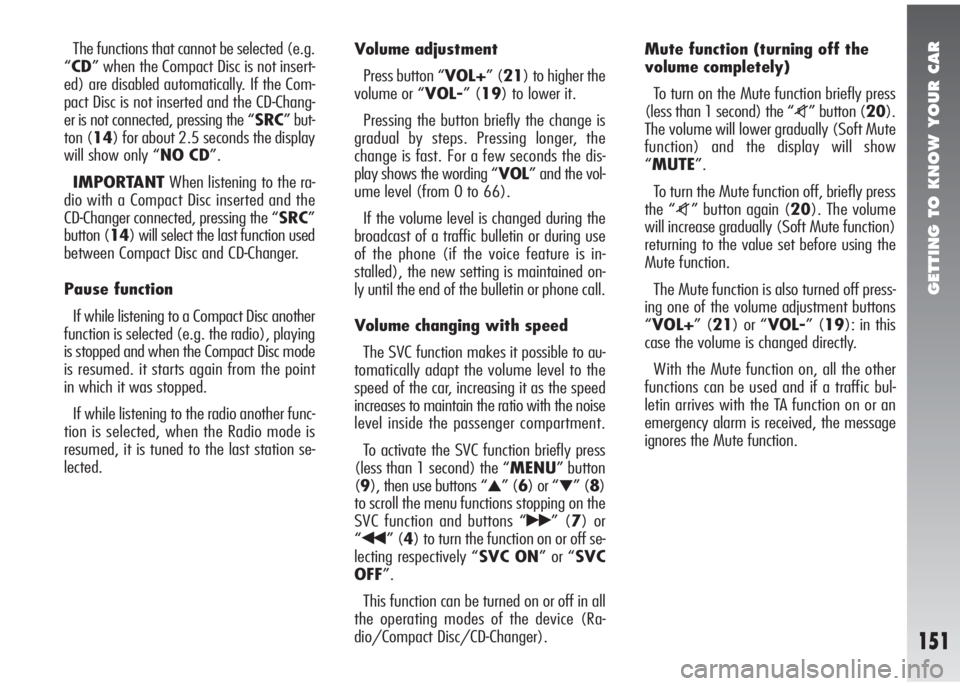
GETTING TO KNOW YOUR CAR
151
The functions that cannot be selected (e.g.
“CD” when the Compact Disc is not insert-
ed) are disabled automatically. If the Com-
pact Disc is not inserted and the CD-Chang-
er is not connected, pressing the “SRC” but-
ton (14) for about 2.5 seconds the display
will show only “NO CD”.
IMPORTANTWhen listening to the ra-
dio with a Compact Disc inserted and the
CD-Changer connected, pressing the “SRC”
button (14) will select the last function used
between Compact Disc and CD-Changer.
Pause function
If while listening to a Compact Disc another
function is selected (e.g. the radio), playing
is stopped and when the Compact Disc mode
is resumed. it starts again from the point
in which it was stopped.
If while listening to the radio another func-
tion is selected, when the Radio mode is
resumed, it is tuned to the last station se-
lected.Volume adjustment
Press button “VOL+” (21) to higher the
volume or “VOL-” (19) to lower it.
Pressing the button briefly the change is
gradual by steps. Pressing longer, the
change is fast. For a few seconds the dis-
play shows the wording “VOL” and the vol-
ume level (from 0 to 66).
If the volume level is changed during the
broadcast of a traffic bulletin or during use
of the phone (if the voice feature is in-
stalled), the new setting is maintained on-
ly until the end of the bulletin or phone call.
Volume changing with speed
The SVC function makes it possible to au-
tomatically adapt the volume level to the
speed of the car, increasing it as the speed
increases to maintain the ratio with the noise
level inside the passenger compartment.
To activate the SVC function briefly press
(less than 1 second) the “MENU” button
(9), then use buttons “
▲” (6) or “▼” (8)
to scroll the menu functions stopping on the
SVC function and buttons “
˙˙” (7) or
“
¯¯” (4) to turn the function on or off se-
lecting respectively “SVC ON” or “SVC
OFF”.
This function can be turned on or off in all
the operating modes of the device (Ra-
dio/Compact Disc/CD-Changer).Mute function (turning off the
volume completely)
To turn on the Mute function briefly press
(less than 1 second) the “
z” button (20).
The volume will lower gradually (Soft Mute
function) and the display will show
“MUTE”.
To turn the Mute function off, briefly press
the “
z” button again (20). The volume
will increase gradually (Soft Mute function)
returning to the value set before using the
Mute function.
The Mute function is also turned off press-
ing one of the volume adjustment buttons
“VOL+” (21) or “VOL-” (19): in this
case the volume is changed directly.
With the Mute function on, all the other
functions can be used and if a traffic bul-
letin arrives with the TA function on or an
emergency alarm is received, the message
ignores the Mute function.